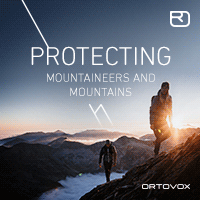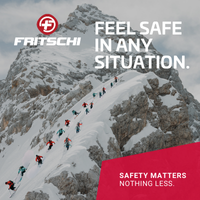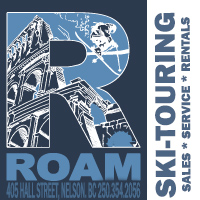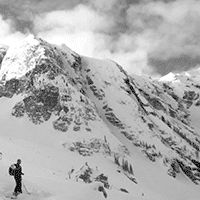Fall Hiking Hit List: The Grand Canyon
Arguably one of the most inspiring landscapes in all of North America has to be the Grand Canyon. While 90% of visitors never leave the canyon’s rim, a hike into the canyon itself should be something every hiker aspires to. The South Rim is by far the more popular of the two main access point (the other being the North Rim) given its accessibility from Phoenix’s international airport only 3.5 hours away. The South Rim sits at an elevation of 2,195m / 7,200ft which is a full 1,040ft lower than the North Rim and thus has a more hospitable climate in winter. The ideal time to hike in the Grand Canyon is early spring or mid-fall when temperatures are not as hot as they are mid-summer. Since there is a 1,430m / 4,700ft elevation loss between the Canyon’s South Rim and the Colorado River below, the temperature extremes can be quite surprising.
On my first trip into the canyon some years ago in mid-October, the weather was in the mid 20’s at the bottom and in the single digits up on the rim (that’s Celsius of course). This time around we were hiking during the hottest period of the year, mid-June. The protocol for avoiding the searing 46°C / 115°F mid-day temps is to start early and end early, and by early I mean 5:00 am starts. The advantage of hiking in early spring or mid-fall is not only the more moderate temperatures but also fewer crowds. Since mid-June was the only permit I could secure we were prepared for excessive heat and people and we were not disappointed on either front.
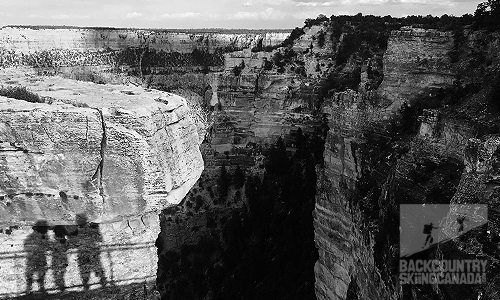
No matter what time of the year you want to hike into the Grand Canyon, you’ll need to apply for a permit in order to camp at any of the three sanctioned campgrounds. For my recent trip, I applied in January and was only awarded a trip date mid-June, and on my second attempt. My permit had our group hiking down the South Kaibab Trail, staying two nights at the Bright Angel Campground at Phantom Ranch, with us returning to the rim via the Bright Angel Trail and staying one night at Indian gardens Campground along the way. Our trip would last 4 days and provide an opportunity to not only camp at the bottom of the canyon but also make the 20km (round trip) hike to Ribbon Falls.
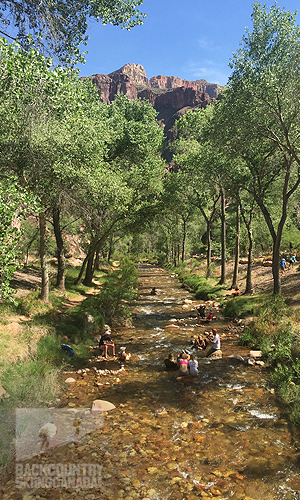
Day one saw us park at the backcountry office parking lot at the South Rim and then take two shuttles to the South Kaibab Trailhead where things literally went downhill from there. Give the logistics required to prepare our gear and effort involved to get to the trailhead we didn’t set foot on the trail until almost 9:00 am. Far too late to avoid the heat of the day. Luckily our group moved relatively fast and was prepared, which allowed us to make it to Bright Angel Campground by 12:30. Upon arriving, the first order of business was to lay in the frigid waters of Bright Angel River and cool down. Once we reduced the risk of hyperthermia we ran into a long time ranger who provided us with invaluable advice, “cool off in the river often and before meals and bed time”. We took his advice to heart and made regular 10min sorties to the river in 30 minutes intervals. That evening as the Sun’s heat waned we explored the sprawling digs at Phantom Ranch then retired early to our tent in preparation for a proper early morning start.
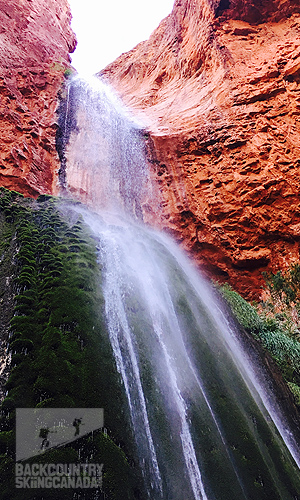
On day two, we awoke at 4:00 am and hit the trail by 5:00. The two-hour hike to Ribbon Falls was surrounded by beautiful twisting and turning canyon walls, the trail was mostly flat and super easy in the cool morning hours. The falls were more impressive than any photo or flowery adjective you’ve seen or read. To truly do them justice you just have to make the trek, so needless to say, don’t miss this one! After an hour of exploring the falls, taking pictures, snacking and resting we headed back to Bright Angel Campground the same way we came. The Canyon walls provided some shade and needed relief from the intensifying morning sun. Making it back to camp by 10:00 am we once again began our ritual of river cooling and relaxing in the shade.
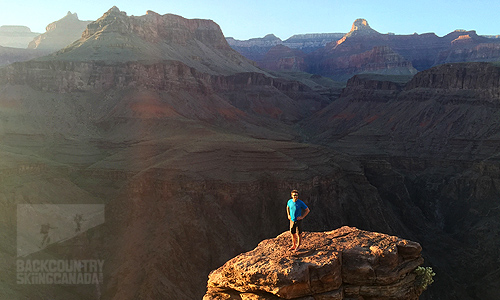
Day three meant it was time for us to make our way back up to the South Rim via the steep, winding Bright Angel trail. We again started early and made it to Indian Gardens Campground well before lunch and in time to choose a primo shaded spots amongst the trees. That evening Plateau Point beckoned us and a short 60 min hike enabled us to watch the sun set over the canyon’s distant western expanse. A relatively short and flat 2.4km / 1.5mile hike each way brought us to a viewing area with a precipitous drop directly down to the Colorado River. Given the ease of this hike, we were able to easily make it back to camp before dark.
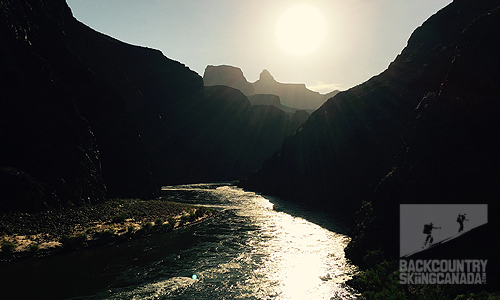
Hesitant to leave the shade and comfort of Indian Gardens on day four, we were slow to start but we also knew that we had to again start early in order to cover the 7.2km / 4.5miles and 925m / 3,040ft elevation gain before the sun breached the South Rim’s eastern flank. While we could not out run the sun’s advance into the sky, the two rest stops at 3-Mile and 1.5-Mile Rest House were a welcome reprive. As we crested the South Rim we took refuge, albeit briefly, in the shade of the two tunnels en route. With a solid two hours of climbing behind us, we reached the South Rim to once again take in the splendour and expansiveness of the views in every direction.
The Grand Canyon is a destination that you will not easily be forgotten once experienced, and given that only 1% of the 10% who leave the rim actually make it down to the Colorado River and Bright Angel Campground, it makes this a truly worth wild destination.
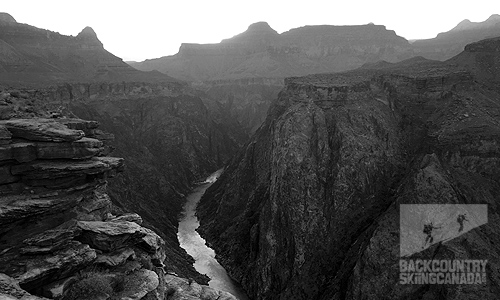
Logistics:
Permits: You can apply for a permit up to four months prior to your proposed start date on the 1st of that month and they cost $10 plus $8 per person per night camped below the rim.
Transportation: Fly into Phoenix International Airport and drive 3.5 hours or 370km / 230 miles north.
Water: There is no water on the South Kaibab Trailhead so prepare accordingly. There is water at Phantom Ranch (along with a restaurant and lodging) and also at Indian Garden Campground.
Hiking: Leave early and arrive at your destination prior to mid day and do not attempt to hike to the Colorado River and back to the rim in one day.
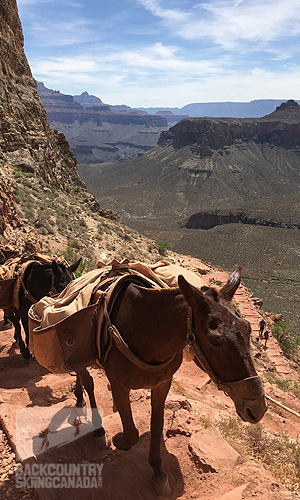
Essentials:
Water: Carry a minimum of two litres of water per person depending upon your hike duration along with a filter system in case you run out.
Food: Enough salty snacks and high-calorie foods to see you through your hike and then some.
First Aid Kit: Should include a blister kit, medications and a knife.
Map: Know your route and trail conditions in advance and know where water is located.
Headlamp: Bring a proper flashlight or head lamp along with spare batteries as a cell phone does not provide enough light to hike with at night, which you may be forced to do.
Sun Protection: Sun screen, hat and sunglasses.
Communication: A whistle or signal mirror as cell phone coverage is limited.
Shelter: A tarp or tent to take shelter from the sun and weather.
Gear: Layer clothes to protect yourself from the sun and ensure your hiking footwear is well broken in. Hiking poles also help lower impact and fatigue on your joints.
Self-Rescue: Be self-sufficient as rescue is never guaranteed immediately due to weather and resources.
Itinerary:
Day One: South Rim Trail to Bright Angel Campground at Phantom Ranch via the South Kaibab Trail — 11.3km / 7miles, 1,430m / 4,700ft elevation loss, 3.5 hours.
Day Two: Bright Angel Campground at Phantom Ranch Campground to Ribbon Falls and back — 23.2km / 14.4miles, 4 hours.
Day Three: Bright Angel Campground at Phantom Ranch to Indian Gardens Campground — 8.1km / 5miles, 395m / 1,300ft, 3.5 hours.
Day Four: Indian Gardens Campground to South Rim via the Bright Angel Trail — 7.2km / 4.5miles, 925m / 3,040ft elevation gain, 2 hours.
Details:
Distance: 49.8km / 30.9miles
Hiking Time: 4 days
Elevation Gain: 1,430m / 4,700ft
Elevation Loss: 1,430m / 4,700ft
Difficulty: Moderate





